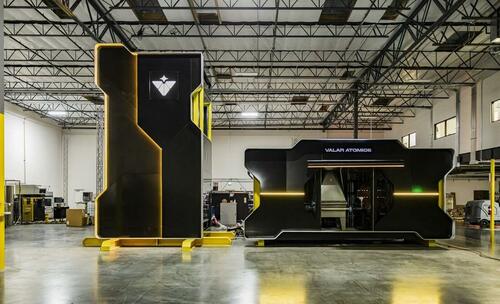Valar Atomics Achieves Cold Criticality With Project NOVA
California-based reactor developer Valar Atomics announced the milestone achievement of obtaining criticality under Project NOVA in collaboration with the Department of Energy’s (DOE) Los Alamos National Lab (LANL). Criticality was achieved at 11:45 AM PT on November 17th.
Zero-power criticality, or “cold criticality”, is the foundational milestone which precedes nuclear operation with power. It is a self-sustaining chain reaction of uranium-235 within a nuclear core, but without reaching full operating temperatures or actively removing heat with a working fluid. Zero-power criticality allows Valar to gain a greater understanding of the neutronic characteristics of the core and verify assumptions about fuel, moderators, active reactivity control, and burnable poisons.
Valar Atomics is a relatively new nuclear startup that has secured $130 million in funding, with participation from Anduril Industries founder Palmer Luckey and Palantir CTO Shyam Sankar, among other investors. Valar’s business model involves mass-producing small modular reactors and clustering them at large sites, or “gigasites,” to power data centers and industrial processes independently of the traditional electricity grid. Unlike many of its peers, Valar is developing advanced nuclear reactors that use a high-temperature gas reactor (HTGR) design with TRISO fuel and helium as a coolant.
Valar’s Project NOVA (Nuclear Observations of Valar Atomics) is currently being conducted at LANL’s National Criticality Experiments Research Center (NCERC) in Nevada. The criticality test began five days earlier on November 12th, as the approach to initial criticality is a slow and controlled process. The reactor being tested is a “zero-power” design, meaning it’s not intended to output thermal energy for conversion to electricity. The primary purpose is to obtain physics data to confirm design characteristics of the Ward250, their reactor included in the DOE’s Reactor Pilot Project.
Adam Stein, the Director for Nuclear Energy Innovation at The Breakthrough Institute, commented “achieving cold criticality represents a milestone for Reactor Pilot Program participants and meets the goal outlined in the recent executive order. This is one step of many toward a functional commercial product”.
NCERC has been used for decades to perform reactor and nuclear weapon physics testing. The recent core physics testing with the Deimos experiment laid the foundation for the NOVA testing. Deimos was the first test in decades using TRISO fuels pellets with HALEU fuel. The benchmarks developed from the Deimos test, along with some of the core’s outer structure, enabled Valar to rapidly achieve this criticality-focused project.
“Valar Atomics provided the reactor core, TRISO fuel, and system configuration.
LANL/ NCERC provided the critical assembly, facility safety envelope, experimentalists, test instrumentation, experiment platform and reflectors, data analysis, and validation oversight”
Valar’s announcement hasn’t discussed the licensing or regulatory pathways that were utilized to enable the criticality testing, but it can be assumed the company coordinated the required permissions and certifications through the DOE, not the NRC. They also likely leveraged the previous data from the Deimos experiment and the lower risk nature of a zero-power reactor to obtain authorization faster.
The other leading reactor developer of micro-HTGRs, Radiant Nuclear, submitted its DOE Authorization Request for Kaleidos (DARK) to the DOE for review. Approval is anticipated by the end of the year. Radiant is pursuing reactor testing at the Demonstration of Microreactor Experiments (DOME) at Idaho National Laboratory (INL).
To provide the comparison between the Project NOVA test and the DOME test — Valar is performing the precursor testing that would be done prior to a test like the one Radiant is about to do at INL. Similar to the testing Valar’s Ward250 reactor will perform in Utah, Radiant will be performing testing for their Kaleidos reactor design add a higher power level than what Project NOVA is achieving, for which the collected data will be used for the eventual NRC licensing of their commercial designs.
In May, President Trump announced the goal of three reactors obtaining criticality prior to July 4th, 2026. The DOE is pursuing this goal by providing 11 reactor projects expedited licensing pathways to take their reactors from powerpoint to actual operations. Valar’s designated reactor, the Ward250, is a High Temperature Gas-Cooled Reactor (HTGR) designed for 100kW. They recently broke ground at their construction site in Utah and claim to be on track to meet the President’s target.

The initial criticality achievement is the first of six total configurations that will be tested for physics data collecting, enabling the eventual testing of the Ward250, as well as future research at the NCERC.
Tyler Durden
Tue, 11/18/2025 – 09:10ZeroHedge NewsRead More




 T1
T1



